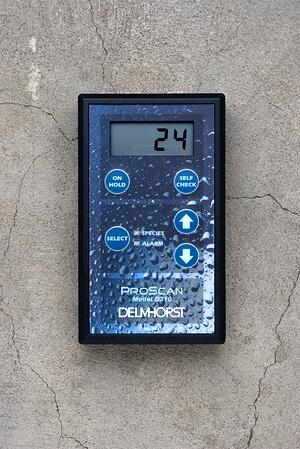 A common question for the Delmhorst team is: “What is a safe moisture level for concrete?” Many people who are new to working with concrete (or have picked up a “concrete moisture meter”) and have heard about the negative effects that excess moisture in concrete can cause may be wondering this exact thing.
A common question for the Delmhorst team is: “What is a safe moisture level for concrete?” Many people who are new to working with concrete (or have picked up a “concrete moisture meter”) and have heard about the negative effects that excess moisture in concrete can cause may be wondering this exact thing.
However, there are some issues with the question:
- Most “Concrete” Moisture Meters Only Check Surface Moisture. Concrete slabs often have thicknesses measured in feet, not inches. Moisture meters can only check the moisture near the surface of a concrete slab, which is not sufficient for predicting how the slab will react to having sealant applied or other building materials installed over it. The top few inches could be bone dry, but the deeper layers of the slab could be holding massive amounts of water.
- Different Concrete Mixes Have Different Physical Properties. There really isn’t a reliable “concrete” scale for moisture meters because the physical properties of concrete mixes can vary greatly from one batch to the next—even when made by the same manufacturer! So, there isn’t a truly accurate way to objectively establish the precise moisture content (%MC) of concrete. This can also affect what a “safe” level of moisture in the slab would be, as denser mixes might be less prone to letting moisture escape all at once.
- The Answer May Depend on Your Next Step. A safe level of moisture in concrete for an outdoor walkway, basketball courtyard, or parking lot will be different from what’s safe for interior applications such as putting a wooden flooring system over concrete or installing a building’s superstructure.
With these issues in mind, how can you check concrete moisture to ensure that your concrete is safe for the next step in your process? What most professionals do to monitor moisture conditions in a concrete slab is the relative humidity (RH) conditions deep in the slab per the ASTM-F-2170 standard.
What is ASTM-F-2170 and How Do I Use it?
ASTM-F-2170 is the standard used to measure moisture deep in a concrete slab through the application of thermo-hygrometers with in-situ probes. Thermo-hygrometers (sometimes called RH meters) are a special kind of moisture-testing device that can be used to monitor temperature and relative humidity conditions in a given area. The in-situ probes are the sensors that can be inserted into the concrete and connected to the meter so readings from deep within the slab can be taken.
The ASTM standard calls for a specific process:
- Prepare a set number of holes to a depth of 40% of the slab’s thickness—at least three holes for the first 1,000 sq. ft. of concrete, and another hole for each additional 1,000 sq. ft.
- Clean out the holes using a wire brush and vacuum.
- Seal the holes with a sensor sleeve and cap to allow them to acclimate for the next 24 hours.
- Insert probes and take a reading with the RH meter.
The thermo-hygrometer’s reading of the humidity in the concrete slab will tell you how much excess moisture is present deep in the slab that might evaporate up through the surface. This can tell you if the concrete is likely to damage the materials above it or suffer other problems.
Exactly how much moisture in concrete would be considered dangerous varies depending on the use and the specific concrete mix you use—which means that you’ll have to consult the manufacturer of both the concrete and whatever flooring system or other materials you plan on installing over the concrete.
Need more information about measuring moisture on the job, or need help finding a moisture meter distributor near you? You can get the answers to your moisture meter questions by contacting Delmhorst today!

Comments